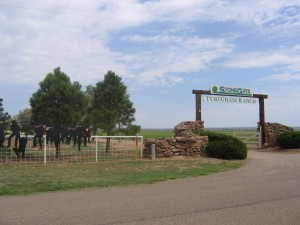Mowing, watering, fertilizing, edging and spraying a home lawn requires commitment and attention. However, it also serves you well and improves your environment.
The next time you are mowing, thinking that Xeriscape may be the ONLY alternative, consider this:
A. The lawn area (approx. 1000 sq.ft. per home) in a block of eight average homes has the cooling effect of about 70 tons of refrigerated air-conditioning. One ton of refrigerated air-conditioning will cool approximately 400 sq.ft. of interior space. The average home requires about 3-4 ton of cooling capacity to perform its function. Consider then, how much energy those lawns save on your electric bill by cooling the exterior areas around your home.
B. Grass and mature trees cool the air and encourage rainfall. Rocked yards, parking lots, sidewalks, streets, stucco homes, etc. perform the opposite!
C. On an extremely hot day, grass can be 15-20 degrees cooler than exposed soil and as much as 40-60 degrees cooler than concrete or asphalt.
D. Acting like a gigantic sponge, lawns absorb all types of airborne pollutants, such as soot, dust and carbon dioxide, as well as noise. While your lawn is busily performing any of these functions, you may not have noticed, it is very quiet and has no moving parts.
E. Recent studies show healthy lawns absorb rainfall 6 times more effectively than a wheat field, 4 times more than a hay field and 50-100 times more than hard-packed dirt – being exceeded only by virgin forest. Lawns hold and filter the rain back to the aquifer, where everyone can use it again, and again, and again!
F. Remember, our planet has every drop of water that has ever been on earth. However, it is redeposited in different ways and areas. Many times it is lost forever, due to man’s ignorance of his environment, such as, banning green areas (grass) in favor of Xeriscape. (See E.)
G. A 50×50 foot healthy grass area will produce enough oxygen to meet the needs of a family of four every day. Most Xeriscape yards provide little to no oxygen.
H. Quality turf grass not only reduces runoff water, it also prevents erosion by water or wind which results in the loss of valuable topsoil. Unfortunately, most Xeriscape yards aren’t even TRUE Xeriscape, and have nothing more than rock and gravel, with sometimes small green plantings, which provides little or no runoff protection.
I. Homes, sports fields and parks, with healthy lawns, provide safer recreation areas where grass acts as a cushion to reduce shock and potential injury. In addition, children can’t or won’t play in rocks, tumbleweeds or sand – they prefer grass.
J. Aesthetically, there can be no argument that a beautiful lawn is immediately pleasing and relaxing in appearance. When comparing a grassed area to a rocked area, there is no question as to which is more pleasurable to the senses.
K. While some may scorn its needs, others find lawn maintenance an excellent opportunity to enjoy reasonable exercise and a break away from the tv, computer, or other household happenings.


 Well, they’re back at it again! We’ve heard that local nurseries might be telling customers that they are getting their sod from us. This happened to us a couple years ago too.
Well, they’re back at it again! We’ve heard that local nurseries might be telling customers that they are getting their sod from us. This happened to us a couple years ago too.